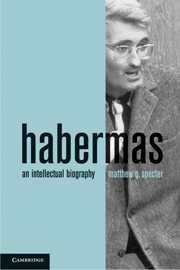Book contents
- Frontmatter
- Contents
- Acknowledgments
- HABERMAS: AN INTELLECTUAL BIOGRAPHY
- Introduction
- 1 The Making of a ′58er: Habermas's Search for a Method
- 2 Habermas as Synthesizer of German Constitutional Theory, 1958–1963
- 3 1961–1981: From the “Great Refusal” to the Theory of Communicative Action
- 4 Civil Disobedience, Constitutional Patriotism, and Modernity: Rethinking Germany's Link to “the West” (Westbindung), 1978–1987
- 5 Learning from the Bonn Republic: Recasting Democratic Theory, 1984–1996
- Conclusion
- Bibliography
- Index
2 - Habermas as Synthesizer of German Constitutional Theory, 1958–1963
Published online by Cambridge University Press: 05 June 2012
- Frontmatter
- Contents
- Acknowledgments
- HABERMAS: AN INTELLECTUAL BIOGRAPHY
- Introduction
- 1 The Making of a ′58er: Habermas's Search for a Method
- 2 Habermas as Synthesizer of German Constitutional Theory, 1958–1963
- 3 1961–1981: From the “Great Refusal” to the Theory of Communicative Action
- 4 Civil Disobedience, Constitutional Patriotism, and Modernity: Rethinking Germany's Link to “the West” (Westbindung), 1978–1987
- 5 Learning from the Bonn Republic: Recasting Democratic Theory, 1984–1996
- Conclusion
- Bibliography
- Index
Summary
Four major themes in Habermas's writings from 1958 to 1963 reveal the influence of the debates and contexts discussed in Chapter 1. The first concerns the plebiscitary deformation of democracy; the other three concern the status of liberal constitutionalism. Habermas's investigation of the first issue seems to have led him in search of a normative theory of the political, something he did not find in American political science. On this point, German constitutional theory seized Habermas's interest, despite it being dominated by the statist approach – a fact that does not attest to a fundamental illiberalism in Habermas's early writings. The repression of the Nazi past by the Smend school had the not-incidental effect of repressing the Social Democratic–republican tradition in legal theory. Indeed, the ideas of Sinzheimer, Kirchheimer, and Fraenkel did not resurface in West Germany until 1965, and Heller's work resurfaced only in 1968, when a “…new generation sought a socially liberal, social-scientifically oriented and politically unreproachable author to reference.” In context, therefore, we can interpret Habermas's appropriation of conservative constitutional theory as a result of a historical lacuna.
- Type
- Chapter
- Information
- HabermasAn Intellectual Biography, pp. 59 - 86Publisher: Cambridge University PressPrint publication year: 2010



